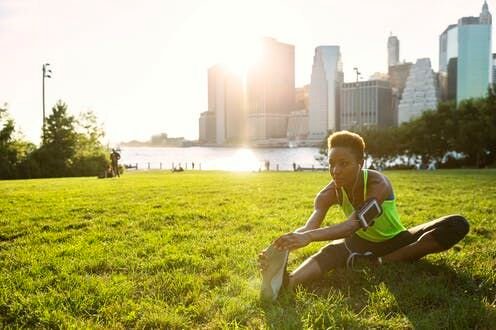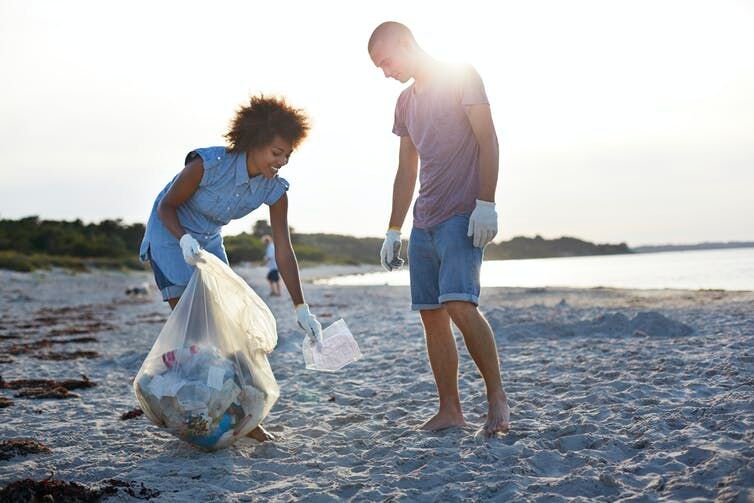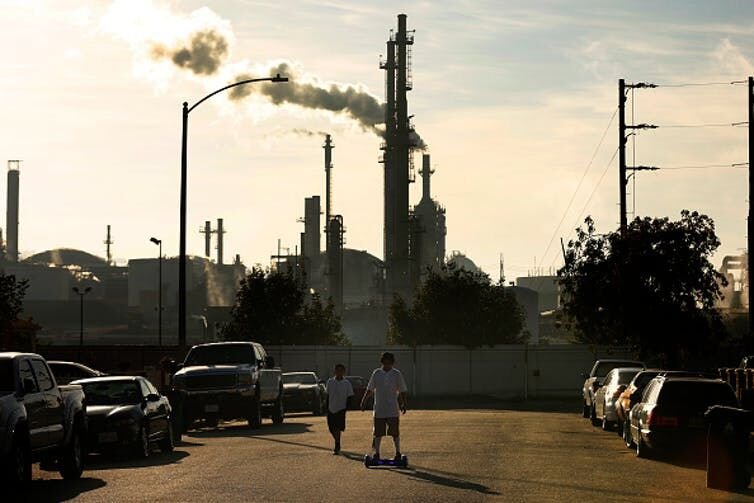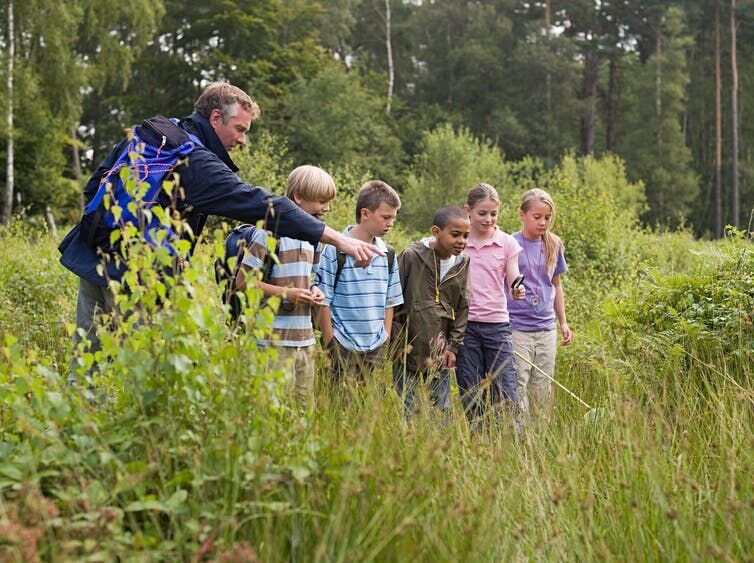
When many people think of New Year’s resolutions, they brainstorm ways to improve themselves for the year ahead. What if we expanded those aspirations to include resolutions that benefit our communities, society and the planet, too?
It might not be a typical approach, but it can broaden your horizons to show ways you can also be of service to others.
Here are four popular New Year’s resolutions with a twist for improving your relationship with nature in 2022 and beyond.
Exercise more consideration for how your actions impact the environment
We each have an environmental ethic reflecting how we value, manage and ultimately relate to nature. Balancing the scales of reciprocity between us and nature – how much we give and take – can improve this relationship in many ways. Whether it’s our addiction to one-use plastics that pile up in landfills or fossil fuels that warm the planet, a mishandled relationship with nature is not doing us or the Earth any favors.
In 2022, we can all take more responsibility for how our actions exacerbate environmental problems. We can also encourage governments and businesses to make it easier for people from diverse socioeconomic backgrounds to protect the environment. This includes making recycled goods affordable and reliable public transportation widely accessible.

Check out the U.S. Environmental Protection Agency’s resources describing some very simple ways to reduce waste at home, work, in our communities and during the holidays. Tips from the website include turning off or unplugging lights during the day, reusing packaging materials and using online billing services instead of paper mail.
Lose the weight of social injustice – it harms nature, too
The perils of social injustice stress multiple aspects of society. Racism and inequality can lead to health disparities, and they also have consequences for the natural environment.
A recent study described how practices such as redlining and residential segregation led to unequal access to nature, excess pollution and biodiversity loss. These practices brought in highways and industries that harm environmental quality in marginalized communities. They also left neighborhoods with fewer parks and trees that provide cooling in summer and benefit the planet.

Perpetuating social ills like systemic racism and inequitable resource allocation is detrimental to the environment, marginalized people and society as a whole.
To help turn this around, you can speak out in your community. Join groups that are trying to promote environmental protection and social justice and are bringing nature back to communities. Call your city, state and Congressional leaders to urge them to take action. Also, refer to the Green 2.0 report’s section on making diversity initiatives successful for concrete ways that you can actualize this in your place of work.
Learn something new about nature and how to reduce harm to the environment and yourself
Clean air, water and soil are fundamental for our survival, but research shows many people lack basic environmental and health literacy to know how to protect themselves.
In 2022, get to know your own impact on the environment. Read more and start exploring ways to preserve the integrity of your area’s natural resources. For example, find out where you can stay abreast of local land-use decisions that impact the environment and your overall community.
You can also support local educators and encourage them to bring the environment into lessons. Environmental issues overlap many other subjects, from history to health. This website includes a framework and materials for educators to help students expand their environmental literacy.

Staying plugged in with media that discuss the latest research can enhance awareness. You can also try tying environmental facts and knowledge into your game night and team-building activities.
Spend more time with family and friends in nature
Studies show that spending time in nature, including urban green spaces, can improve your relationship with nature and with others.
Time in nature can increase social cohesion. Throughout the pandemic, many people discovered the outdoors as a place to decompress and reduce stress. Spending more time outdoors can encourage social interactions that benefit health, buffer emotional distress and encourage use of these spaces, which can help protect them for the future.
Here are some tools that outline best practices to enhance parks and recreation near you. Also, here are ways to make outdoor environments more inclusive for families in diverse communities.
Collectively, thinking about our relationship with nature and finding ways to protect the environment can help us be better stewards of the planet.
[Too busy to read another daily email? Get one of The Conversation’s curated weekly newsletters.]
Viniece Jennings serves as a consultant to the National Recreation and Parks Association on a diversity, equity and inclusion initiative. She is also a colleague to Dr. Tony Reames in the JPB Environmental Health fellowship at Harvard University’s T.H. Chan School of Public Health.
This article is republished from The Conversation under a Creative Commons license.
-
4 New Year’s resolutions for a healthier environment in 2022
Canva
Every piece of plastic ever made still exists.
That’s because, while plastic will break down into smaller and smaller bits, it is unable to biodegrade. Wood, wool, and other organic matter can break down into soil. But plastic just keeps breaking off into tinier pieces, first small enough to choke an animal or cause internal damage and later as microplastics rife with toxins and tiny enough to be transported through the bloodstream.
Despite this, plastic production isn’t slowing down—in fact, it jumped from 2.3 million tons in 1950 to 448 million tons by 2015 and will likely double that by 2050. And the vast majority of it isn’t getting recycled; a lot of it isn’t even making it to landfills. Roughly 8 million tons of plastic end up in oceans, where marine life is dying and water is growing increasingly poisonous.
Calls for companies to reduce or eliminate their plastic packaging and ingredients have grown louder, and more companies than ever are popping up green options for products themselves and their containers. But consumers can also effect change by shifting demand and voting for more sustainable options with their wallets.
Almond Cow compiled a list of 10 simple tips for a (mostly) plastic-free life. Keep reading to discover some inspired ways to make small changes in your daily life that can lead to much bigger waves.

Canva
Every piece of plastic ever made still exists.
That’s because, while plastic will break down into smaller and smaller bits, it is unable to biodegrade. Wood, wool, and other organic matter can break down into soil. But plastic just keeps breaking off into tinier pieces, first small enough to choke an animal or cause internal damage and later as microplastics rife with toxins and tiny enough to be transported through the bloodstream.
Despite this, plastic production isn’t slowing down—in fact, it jumped from 2.3 million tons in 1950 to 448 million tons by 2015 and will likely double that by 2050. And the vast majority of it isn’t getting recycled; a lot of it isn’t even making it to landfills. Roughly 8 million tons of plastic end up in oceans, where marine life is dying and water is growing increasingly poisonous.
Calls for companies to reduce or eliminate their plastic packaging and ingredients have grown louder, and more companies than ever are popping up green options for products themselves and their containers. But consumers can also effect change by shifting demand and voting for more sustainable options with their wallets.
Almond Cow compiled a list of 10 simple tips for a (mostly) plastic-free life. Keep reading to discover some inspired ways to make small changes in your daily life that can lead to much bigger waves.

-
4 New Year’s resolutions for a healthier environment in 2022
Oleksandr Berezko // Shutterstock
What do acrylic, lycra, nylon, polyester, and spandex have in common? They’re all synthetic fabrics made of plastic. Everytime you wash them, they’re shedding microplastics. The International Union for Conservation of Nature estimates that these plastic particles from clothing, tires, and the like account for as much as 30% of the microplastics polluting oceans around the world. In addition to this shedding, when the clothing item eventually gets thrown out, it will break down into ever-smaller pieces that make their way into the soil and water supply while harming ecosystems and organisms along the way.
You can sidestep plastics in clothing entirely by simply checking labels to be sure you’re paying for 100% cotton, hemp, or other biodegradable fibers. If you’re shopping online, be sure to request no plastic packaging—and bring your own reusable bag for in-person shopping. For shoes, look for natural materials and natural rubber soles over plastic.
If you’ve simply got to have that stretch in your clothes, pay a visit to your local thrift store where you’ll save money while keeping wardrobe essentials out of landfills. For clothing items you already have with synthetic fibers, there are products now that claim to catch microplastics and prevent them from running out with the laundry’s wastewater.
Lastly, if you haven’t already, learn how to conduct simple modifications and repairs on your clothes and shoes, or get to know your local tailor or cobbler. The less you buy and the more you make use of what you have, the better for the environment.
Oleksandr Berezko // Shutterstock
What do acrylic, lycra, nylon, polyester, and spandex have in common? They’re all synthetic fabrics made of plastic. Everytime you wash them, they’re shedding microplastics. The International Union for Conservation of Nature estimates that these plastic particles from clothing, tires, and the like account for as much as 30% of the microplastics polluting oceans around the world. In addition to this shedding, when the clothing item eventually gets thrown out, it will break down into ever-smaller pieces that make their way into the soil and water supply while harming ecosystems and organisms along the way.
You can sidestep plastics in clothing entirely by simply checking labels to be sure you’re paying for 100% cotton, hemp, or other biodegradable fibers. If you’re shopping online, be sure to request no plastic packaging—and bring your own reusable bag for in-person shopping. For shoes, look for natural materials and natural rubber soles over plastic.
If you’ve simply got to have that stretch in your clothes, pay a visit to your local thrift store where you’ll save money while keeping wardrobe essentials out of landfills. For clothing items you already have with synthetic fibers, there are products now that claim to catch microplastics and prevent them from running out with the laundry’s wastewater.
Lastly, if you haven’t already, learn how to conduct simple modifications and repairs on your clothes and shoes, or get to know your local tailor or cobbler. The less you buy and the more you make use of what you have, the better for the environment.
-
-
4 New Year’s resolutions for a healthier environment in 2022
Leonardo Moreno C // Shutterstock
An estimated 250 million people in 2020 used body wash in plastic containers, amounting to around 1.4 billion body wash bottles being thrown out last year alone.
There are countless companies and individual vendors making and selling bar soap for the body and hair at every price point, scent, and style. Solid bars are also available as shave soaps and deodorant.
For shaving, you can get a lifetime of use out of a safety razor without all the waste of the plastic versions that need to constantly be replaced.
Leonardo Moreno C // Shutterstock
An estimated 250 million people in 2020 used body wash in plastic containers, amounting to around 1.4 billion body wash bottles being thrown out last year alone.
There are countless companies and individual vendors making and selling bar soap for the body and hair at every price point, scent, and style. Solid bars are also available as shave soaps and deodorant.
For shaving, you can get a lifetime of use out of a safety razor without all the waste of the plastic versions that need to constantly be replaced.
-
4 New Year’s resolutions for a healthier environment in 2022
Space_Cat // Shutterstock
Around 1 billion toothbrushes get tossed in American garbage cans each year, adding roughly 50 million pounds of plastic waste to landfills. Many end up in waterways and oceans, but it doesn’t have to be this way.
Biodegradable dental floss and (mostly) biodegradable toothbrushes have hit the mainstream—and toothpaste can now be found in glass jars, recyclable aluminum tubes, and even as tablets wrapped in eco-friendly packaging.
Space_Cat // Shutterstock
Around 1 billion toothbrushes get tossed in American garbage cans each year, adding roughly 50 million pounds of plastic waste to landfills. Many end up in waterways and oceans, but it doesn’t have to be this way.
Biodegradable dental floss and (mostly) biodegradable toothbrushes have hit the mainstream—and toothpaste can now be found in glass jars, recyclable aluminum tubes, and even as tablets wrapped in eco-friendly packaging.
-
-
4 New Year’s resolutions for a healthier environment in 2022
Olga Navarro // Shutterstock
Make it effortless to avoid plastic while you’re out by bringing along eco-friendly, reusable containers for leftovers from the restaurant or to drop off at the time of placing a to-go order. When you get a pizza, ask the person taking your order not to include the little plastic “pizza saver” at the center of the pie.
Reusable containers today are as varied as glass, collapsible silicone with lids, or resealable bags.
Olga Navarro // Shutterstock
Make it effortless to avoid plastic while you’re out by bringing along eco-friendly, reusable containers for leftovers from the restaurant or to drop off at the time of placing a to-go order. When you get a pizza, ask the person taking your order not to include the little plastic “pizza saver” at the center of the pie.
Reusable containers today are as varied as glass, collapsible silicone with lids, or resealable bags.
-
4 New Year’s resolutions for a healthier environment in 2022
Canva
There’s virtually no reason to continue using unsustainable cleaning products while the market is so saturated with sustainable options and making your own supplies is so economical and easy.
Store-bought options include concentrated refill packs, tablets that can be dropped into a spray bottle with water, or powdered cleaning products in cardboard boxes. There are also plenty of online recipes if you want to make your own cleaning supplies.
Biodegradable sponges and scouring pads can replace options with plastic components—as can wooden scrub brushes, toilet brushes, natural cleaning cloths, or rags made from old clothing or towel scraps.
Canva
There’s virtually no reason to continue using unsustainable cleaning products while the market is so saturated with sustainable options and making your own supplies is so economical and easy.
Store-bought options include concentrated refill packs, tablets that can be dropped into a spray bottle with water, or powdered cleaning products in cardboard boxes. There are also plenty of online recipes if you want to make your own cleaning supplies.
Biodegradable sponges and scouring pads can replace options with plastic components—as can wooden scrub brushes, toilet brushes, natural cleaning cloths, or rags made from old clothing or towel scraps.
-
-
4 New Year’s resolutions for a healthier environment in 2022
j.chizhe // Shutterstock
If you keep reusable shopping and produce bags in your car or at your front door, you’ll be more likely to remember them when you head off to the market. If you have a local grocer with a bulk foods section, you can also bring your own containers. Store employees are used to subtracting the weight of containers from the total weight of the item. Be ready with plastic-free containers at the deli counter.
While you’re shopping, choose products without plastic packaging. Look for fresh bread in paper bags—or, at a bakery, come ready with your own cloth to put it in. If you’re ordering online, be mindful of how things are packaged and shipped.
j.chizhe // Shutterstock
If you keep reusable shopping and produce bags in your car or at your front door, you’ll be more likely to remember them when you head off to the market. If you have a local grocer with a bulk foods section, you can also bring your own containers. Store employees are used to subtracting the weight of containers from the total weight of the item. Be ready with plastic-free containers at the deli counter.
While you’re shopping, choose products without plastic packaging. Look for fresh bread in paper bags—or, at a bakery, come ready with your own cloth to put it in. If you’re ordering online, be mindful of how things are packaged and shipped.
-
4 New Year’s resolutions for a healthier environment in 2022
antoniodiaz // Shutterstock
Most household trash is composed of food scraps that can be composted and plastic containers from store-bought food. Many items that come in plastic packaging—from mayonnaise and granola to soy or nut milk—couldn’t be easier to make at home.
Items like a glass blender or stainless steel juicer will pay for themselves many times over for how much you save by not buying packaged items at a store.
antoniodiaz // Shutterstock
Most household trash is composed of food scraps that can be composted and plastic containers from store-bought food. Many items that come in plastic packaging—from mayonnaise and granola to soy or nut milk—couldn’t be easier to make at home.
Items like a glass blender or stainless steel juicer will pay for themselves many times over for how much you save by not buying packaged items at a store.
-
-
4 New Year’s resolutions for a healthier environment in 2022
Mr.Whiskey // Shutterstock
The Environmental Protection Agency estimates that 1.6 billion pens are thrown in the trash each year. When you’ve run down your supply of plastic pens in your kitchen’s junk drawer, consider springing for a refillable fountain pen that will feel like a luxury every time you use it.
Compostable cellphone cases are now widely available to replace plastic; and day planners, notebooks, and the like are easy to find without plastic covers or spines.
While you’re at work, be mindful of drinking out of coffee mugs and glasses instead of plastic or foam versions. If your office doesn’t have metal silverware, bring some in from home. Pro tip: Get a metal spork to keep in your car, your purse, or your desk in a pinch—some foldable sporks will even fit in a wallet.
Mr.Whiskey // Shutterstock
The Environmental Protection Agency estimates that 1.6 billion pens are thrown in the trash each year. When you’ve run down your supply of plastic pens in your kitchen’s junk drawer, consider springing for a refillable fountain pen that will feel like a luxury every time you use it.
Compostable cellphone cases are now widely available to replace plastic; and day planners, notebooks, and the like are easy to find without plastic covers or spines.
While you’re at work, be mindful of drinking out of coffee mugs and glasses instead of plastic or foam versions. If your office doesn’t have metal silverware, bring some in from home. Pro tip: Get a metal spork to keep in your car, your purse, or your desk in a pinch—some foldable sporks will even fit in a wallet.
-
4 New Year’s resolutions for a healthier environment in 2022
sandyman // Shutterstock
From compostable doggie bags to shampoo bars for dogs and cats, waste-free living has officially entered the pet market. Natural cat litter can be found packaged in paper and cardboard, while plenty of toys feature natural fibers and woods instead of plastic pieces that can be harmful if swallowed.
Metal feeding bowls and troughs will offer a much longer shelf life than plastic counterparts and will not degrade with proper upkeep. Gently used pet carriers can be found at yard sales or online marketplaces, and you’ll save some money in the process.
When it comes time for treats, recipes you can make at home are surprisingly simple and come without all that extra packaging.
sandyman // Shutterstock
From compostable doggie bags to shampoo bars for dogs and cats, waste-free living has officially entered the pet market. Natural cat litter can be found packaged in paper and cardboard, while plenty of toys feature natural fibers and woods instead of plastic pieces that can be harmful if swallowed.
Metal feeding bowls and troughs will offer a much longer shelf life than plastic counterparts and will not degrade with proper upkeep. Gently used pet carriers can be found at yard sales or online marketplaces, and you’ll save some money in the process.
When it comes time for treats, recipes you can make at home are surprisingly simple and come without all that extra packaging.
-
-
4 New Year’s resolutions for a healthier environment in 2022
Freedomz // Shutterstock
Everyone loves receiving a thoughtful gift—and yet gift-giving is among the most wasteful things we do. On average, Americans toss 25% more trash from Thanksgiving to New Year’s Day than any other time of year. That’s largely because so much of the gift-giving process is single-use: A greeting card gets smeared in glitter that renders the card as unrecyclable as the gift wrap. The tape on the wrapping is almost always plastic, and the items themselves are often made in whole or part of plastic.
When it comes time to give a gift, consider items built sustainably that will last for years. You can also consider locally sourced flowers; experiences like tickets to a show, help with a project, or a great meal at a restaurant; or handmade items with sustainable materials.
This story originally appeared on Almond Cow and was produced and distributed in partnership with Stacker Studio.
Freedomz // Shutterstock
Everyone loves receiving a thoughtful gift—and yet gift-giving is among the most wasteful things we do. On average, Americans toss 25% more trash from Thanksgiving to New Year’s Day than any other time of year. That’s largely because so much of the gift-giving process is single-use: A greeting card gets smeared in glitter that renders the card as unrecyclable as the gift wrap. The tape on the wrapping is almost always plastic, and the items themselves are often made in whole or part of plastic.
When it comes time to give a gift, consider items built sustainably that will last for years. You can also consider locally sourced flowers; experiences like tickets to a show, help with a project, or a great meal at a restaurant; or handmade items with sustainable materials.
This story originally appeared on Almond Cow and was produced and distributed in partnership with Stacker Studio.




